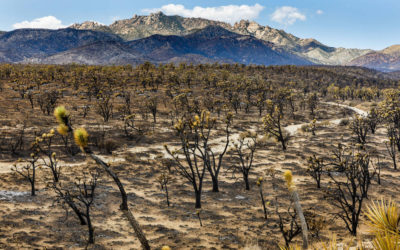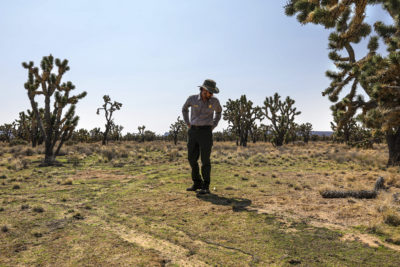In 2020, the Dome Fire swept through Southern California’s Mojave National Preserve, blackening nearly 70 square miles of the biodiverse desert. The fire killed 1.3 million Joshua trees, most of them in Semar Dome, one of the world’s largest and most dense Joshua tree forests.
Then, in 2023, the York Fire swept through, burning large swaths of adjacent Joshua tree forest and killing an estimated 1 million more trees. The destruction of Semar Dome, which is higher and cooler than the surrounding desert, was a particularly devastating blow to the National Park Service and conservationists who viewed it as a stronghold of eastern Joshua trees and key to the species’ future.
Experts had planned to turn Semar Dome into a refuge by removing invasive grasses and monitoring forest health, said Andrew Kaiser, a botanist who worked in the Mojave National Preserve at the time of the fire and now works for the California Department of Fish and Wildlife, developing a western Joshua Tree conservation plan. “The boundaries of the 2020 Dome Fire were essentially the exact outlines of the model climate refuge. It almost overlapped completely.”
Studies show that if global warming is not slowed, nearly 100 percent of our trees could disappear within the next few decades.
The number of wildfires that kill or damage Joshua trees has skyrocketed in recent years “in large part because of changes in the desert ecosystem,” said Brendan Cummings, a Joshua Tree resident and conservation director for the Center for Biological Diversity who has been a leader in the fight to legally protect the trees. “Thirty years ago, a typical fire in a Joshua tree forest would burn less than an acre. Lightning would hit the tree and it would fall. It rarely burned more than an acre.” Now, he said, larger fires are common.
These fires are one of the major threats to Joshua trees. Hot, dry weather, which kills seedlings and reduces recruitment of new trees, is another important factor. 2019 and 2011 They found that if global warming is not mitigated, nearly 100 percent of the trees across parts of the American Southwest could be gone in the next few decades, especially if the development of utility-scale solar farms doesn’t first kill them.
The Joshua tree is a type of yucca. With its rough bark and serrated leaves at the ends of its curved branches, it looks like something straight out of a Dr. Seuss book. The Spanish call it desert islandDesert Dagger, and that’s what the local Kahuiya tribe calls it. Humwich and. The Mormon settlers named this tree after the prophet Joshua, who lifted up his hands to lead the Israelites. Mature trees range in age from 75 to over 300 years, while saplings take about 30 years to mature.
Yale Environment 360
There are two distinct subspecies of Joshua trees: the western Joshua tree, found primarily in California (including its home in Joshua Tree National Park), and the eastern species, found in much of eastern California, southern Nevada, western Arizona, and a small corner of Utah. Each relies on a single species of moth for pollination, a moth that does not pollinate other species.
They’re also essential to desert biodiversity. “They’re a keystone species, creating more habitat for other species and increasing the biodiversity of the entire desert,” says Cameron Barros, a retired research ecologist who studies Joshua trees at the University of California, Riverside. “The density and abundance of everything from red-tailed hawks to great horned owls to Scott’s hawks to cactus robins is related to the availability of nesting sites, and Joshua trees are actually the only nesting sites in much of the Mojave Desert.”
Desert lizards use fallen tree branches as shelter, endangered desert tortoises eat Joshua tree flowers, and black-tailed jackrabbits and desert tree rats rely on water stored in trunk tissue.
Climate change is playing a major role in the changing fire regimes of the Mojave. The vast increase in burned area is partly due to warmer temperatures, which are causing invasive grasses to grow at a faster rate. The average temperature in the desert has increased by 3.6 degrees Fahrenheit (2 degrees Celsius) over the past 100 years, and in some areas precipitation has decreased by up to 20 percent. The Mojave, the driest place in North America, receives a wide range of rainfall, but averages 5 inches per year. Joshua trees are highly adapted to the Mojave’s intense heat, thriving in temperatures above 120 degrees Fahrenheit (49 degrees Celsius). But they also need moisture, and climate change has brought drought.

In August 2023, the York Fire burned approximately 1 million Joshua trees in the Mojave National Preserve.
LE Baskow / Las Vegas Review-Journal / Tribune News Service via Getty Images
Climate change is expected to continue to have impacts. Extreme change The weather in California will affect the next few years. While recent wet winters have helped new Joshua tree seedlings to sprout, survival is not guaranteed. Joshua trees need a reliable supply of water to survive the first few years.
“Temperature is important, but precipitation is really important,” Barrows said. “When you combine higher temperatures with drier conditions, you’re screwed.”
At the same time, wet years help establish plant species that threaten Joshua trees. “In the past few decades, invasive grasses originally brought here by cattle ranches and other sources have taken over the Mojave. [changing] “It’s a fire regime,” Cummings said. Grasses like red brome and Mediterranean split grass are highly flammable and tend to grow thickly in wet years, causing more intense and much more widespread fires.
There is also apprehension The invasion of exotic species, combined with climate change and the buildup of atmospheric nitrogen flowing into the foggy Los Angeles basin, Promotes growth In the case of flammable grasses — it will prevent Joshua trees from recovering on their own after a fire. Instead, the area may be converted to non-native grasslands with low biodiversity.
Ironically, one of the biggest threats to trees is the massive solar panels being built in California to help wean the country off fossil fuels.
The western Joshua tree is listed as threatened under the California Endangered Species Act, and will be regulated under the state’s Western Joshua Tree Protection Act, which prohibits cutting the tree on private or public lands without a state permit beginning in 2023. Under both the Trump and Biden administrations, the federal government has declined to seek federal endangered species protection for both subspecies, most recently in 2023.
One reason for the lack of protection is that Joshua trees are not currently scarce. Threats are based on projections of future loss. The eastern Joshua tree population is estimated at several million, while the western population is estimated at 10 million. Nevertheless, Cummings argues that both deserve protection because the projections for the future look grim. “Given the threat of climate change, we know they are on a trajectory to extinction,” he said. “If climate change were to freeze at current levels, we would [still] Of course, the temperature is not expected to remain constant.
Another potential threat to the western species is development in the Mojave Desert, where half of the trees grow on private land. (Most eastern Joshua trees grow on public land.) Ironically, one of the biggest threats to the trees is the massive solar arrays that are helping to wean the state off fossil fuels. The 530-megawatt Aratina Solar-Storage Project, to be built on private land near Boron, California, will kill about 4,000 Joshua trees, reducing habitat for desert tortoises and other species.

Desert tortoises, red-tailed hawks, and black-tailed rabbits all depend on Joshua trees for their habitat.
Daniel Elsbrock / NPS; Preston Jordan Jr. / NPS; Brad Sutton / NPS
Solar developers object to the tree being listed as threatened. They argue that the California desert, along with the North African desert, has the highest solar radiation in the world, making it ideal for generating electricity. “Our grid capacity needs to expand at an unprecedented rate,” Shannon Eddy, executive director of the Large-Scale Solar Association, told Vice News. “We’re at the forefront of figuring that out. So to take vast swaths of desert and limit solar development before we actually know where it’s going to go is not appropriate.”
The Western Joshua Tree Conservation Act, which allows exemptions for some solar projects, came as the California Department of Fish and Wildlife was deadlocked over whether to list the subspecies as endangered. The law, a political compromise, passed because it offered more management flexibility than the tree classification.
The bill requires the Department of Fish and Wildlife to draft a conservation plan for the species by Dec. 31, 2024, in conjunction with other government agencies, California Native American tribes and the public, and requires companies to purchase permits to cut or relocate Joshua trees. Permit fees would be used to create a conservation fund. The plan aims to protect not only the trees, but also the larger Mojave Desert ecosystem, including the trees, desert tortoises, burrowing owls, rare plants, yucca moths and other species, from the pressures of development.
“It’s not perfect,” Cummings said. “But it’s going to bring things into a reasonable, orderly, legal space. High desert communities have done a really great job of protecting their desert landscapes from development.”

National Park Service botanist Drew Kaiser investigates invasive red bromeliad in the Mojave National Preserve.
Irrfan Khan / Los Angeles Times via Getty Images
One of the key parts of an emerging conservation strategy, according to some recent guidelines, is paper Published in the journal Biological conservationIt’s about protecting the trees in the refuge. The refuge is a designated area where the Joshua tree forest is healthy and can be cooler and less vulnerable to drought as temperatures rise. In Joshua Tree National Park, for example, managers clear grass in the refuge to remove fuel and create firebreaks between the trees.
Researchers are also mapping the genomes of trees to predict which populations are most tolerant of heat and drought, so they can be prioritized for preservation or to use as seeds for replanting.
Assisted relocation, which would physically move the mature trees to Northern California and Oregon, has been considered. But “you can’t just move the Joshua trees,” said Kaiser of the California Department of Fish and Wildlife. “You have to move the nurse plants. [which help seedlings get established]. We need to move the yucca moth pollinator. We need to monitor it. Based on all the research I’ve seen so far, it’s not a viable option at this point. But I’m not ruling it out.”
Despite all these threats, there are glimmers of hope. For example, increased use of electric vehicles in Southern California may reduce atmospheric nitrogen levels that promote the growth of flammable grasses.
And there is a broad commitment from concerned partners. “In well-managed areas, like the national parks, we are optimistic,” says UC Riverside’s Barros. “Interestingly, there are areas where the trees are actually encroaching on pine forests, where they thrive because they are taller, cooler, and wetter. So Joshua trees are not going to go extinct as a species, but the loss of Joshua trees is going to make the Mojave Desert region ecologically poorer, unless we reverse the climate change problem.”






